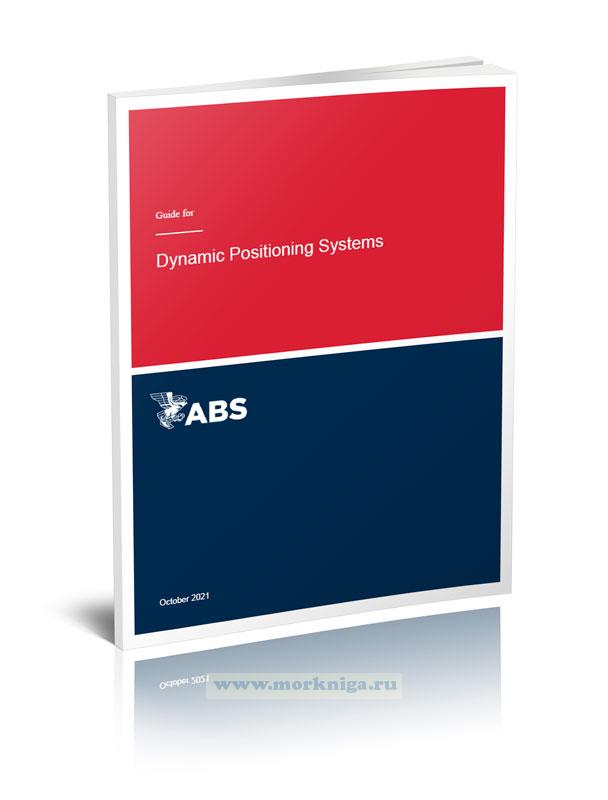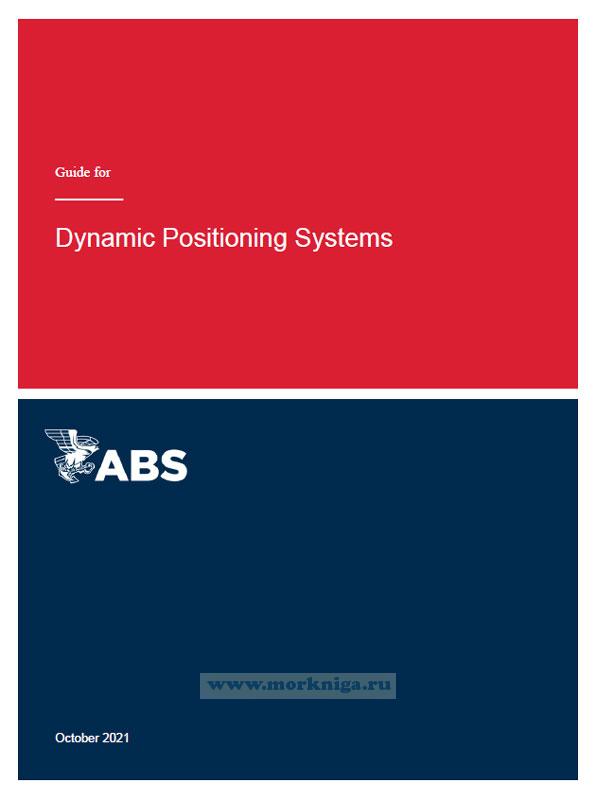Guide for Dynamic Positioning Systems/Руководство по системам динамического позиционирования
Книга на английском языке
The application of dynamic positioning (DP) systems has been expanded significantly not only in thenumber of DP vessels, but also in the range of applications and the advancement of DP technologies. Inorder to address this variety and the needs of industry, ABS undertook to develop an ABS Guide forDynamic Positioning Systems. The Guide replaces ABS DP system requirements currently included in theABS Rules for Building and Classing Marine Vessels (Marine Vessel Rules).In addition to the current requirements, the Guide provides new optional notations and technical specificsthat reflect current industry practice and DP technologies.
Contents
Section 1 General
1 Introduction
3 Classification Notation
5 Definitions
5.1 General
5.3 Equipment and Dynamic Positioning System
5.5 Redundancy Design
5.7 Performance and Operation
7 Documentation
7.1 Dynamic Positioning System
7.3 Power System
7.5 Thruster System
7.7 DP Control System
9 Certification
9.1 Control and Monitoring System Equipment
9.3 Components and Subsystems
Section 2 Dynamic Positioning System Design
1 General
3 DP System Technical Requirements
3.1 Basic Requirements
3.3 Redundancy Design
3.5 Physical Separation
3.7 DP System Equipment Requirements
3.9 Station Keeping Performance
5 Essential Non-DP Systems
5.1 General
5.3 Emergency Shutdown System and DP Redundancy
5.5 Fire Protection
5.7 Fuel Quick Closing Valves
7 Alarms, Monitoring and Instrumentation
9 Communications and DP Alert System
9.1 Communications
9.3 DP Alert System
11 Failure Mode and Effects Analysis
11.1 General
11.3 Failure Mode Analysis
11.5 FMEA Report
13 DP Operations Manual
Table 1 Summary of DP System Requirements for ABS DPS Notations(4)
TABLE 2 Summary of Minimum Instrumentation at DP Control Station (1 November 2013)
Section 3 Power Systems
1 General
3 Power Generation System
3.1 Vessels with DPS-1 Notation
3.3 Vessels with DPS-2 Notation
3.5 Vessels with DPS-3 Notation
5 Power Distribution (1 November 2013)
5.1 General
5.3 Vessels with DPS-2 or DPS-3 Notations
7 Power Management System
9 Uninterruptible Power Supply Systems (UPS)
11 Energy Storage Systems Supporting Dynamic Positioning Operations
11.1 General
11.3 Considerations when Installing Energy Storage Systems
13 Fault Ride Through (FRT) Capability
13.1 General
13.3 Pre-requisites for a live FRT capability test
13.5 Live Test Requirements
15 DC Power Distribution Systems
15.1 General
15.3 DC Control Power Supplies & Battery Systems
15.5 DC Power Generation and Distribution System
Table 1 Requirements for ESS
Section 4 Thruster System
1 General
3 Thruster Capacity
5 Thruster Configuration
7 Thruster Auxiliary System
9 Thruster Control
9.1 General
9.3 Control Parameter
9.5 Manual Thruster Control (1 November 2013)
9.7 Emergency Stop
11 Thruster Monitoring and Alarm (1 November 2013)
Section 5 Control System
1 General
3 DP Control Station
3.1 General
3.3 Arrangement of DP Control Station (1 November 2013)
3.5 Arrangement of DP Control Systems
3.7 Arrangement of Control Panels
3.9 Arrangement of Data Communication Networks
5 DP Control System
5.1 General (1 November 2013)
5.3 External Force
5.5 Vessels with DPS-2 Notation
5.7 Vessels with DPS-3 Notation
5.9 Vessels with DPS-1+, DPS-2+ or DPS-3+ Notation
7 Manual Position Control System
9 Control Mode Selection
9.1 Manual/DP Control Modes (1 November 2013)
9.3 Main/Backup Control Station
11 Position Reference System and Environment Sensor
11.1 General
11.3 Vessels with DPS-0 or DPS-1 Notation
11.5 Vessels with DPS-2 Notation (1 November 2013)
11.7 Vessels with DPS-3 Notation
11.9 Signal Processing
13 Consequence Analysis (For DPS-2 and DPS-3)
15 Display and Monitoring (1 September 2015)
Section 6 Auxiliary Systems (applies to DPS-2 and DPS-3)
1 General
3 Fuel Oil (1 September 2015)
5 Cooling Water (1 November 2013)
7 Compressed Air
9 Lubrication Oil Systems (1 November 2013)
11 HVAC and Ventilation
13 Piping
15 Pneumatic Systems
17 Power Supply to Auxiliary Systems (1 November 2013)
Section 7 DP System Initial Test
1 General
3 DP System Performance Test
3.1 Uninterruptible Power Supply Systems (UPS)
3.3 Position Reference Systems and Sensors
3.5 Manual Position Control System (1 November 2013)
3.7 Manual Thruster Control System (1 November 2013)
3.9 Thruster Emergency Stop
3.11 DP Control System (1 November 2013)
3.13 Control and Alarms (1 November 2013)
3.15 Standby Changeover
3.17 Protection Function
3.19 Communication
3.21 DP Endurance Test (1 November 2013)
5 FMEA Proving Trial for DPS-2 or DPS-3
7 Surveys After Construction
Section 8 Enhanced System (EHS)
1 Introduction
3 Enhanced System for DPS-2 and DPS-3
3.1 Enhanced Electrical System (EHS-E)
3.2 Enhanced Power and Thruster System (EHS-P)
3.3 Control System (EHS-C)
3.5 Fire and Flood Protection (EHS-F)
5 Summary of System Requirements for Enhanced System Notations)
7 Closed Bus and Standby Redundancy
7.1 General
7.3 Closed Bus Operation
7.5 Standby Start
7.7 FMEA and Testing
9 Documentation
Table 1 Summary of DP System Requirements for EHS
Notations
Section 9 Station Keeping Performance
1 General
1.1 Definition
3 Environmental Conditions
3.1 Wind
3.3 Wave and Wave Spectrum
3.5 Current
3.7 Environments for SKP(a,b,c,d,e,f) Notation
3.9 Environments for SKP Notation
5 Analysis Conditions
5.1 DP System Configurations
5.3 Operating Conditions
7 Environmental Load Calculation
7.1 Wind and Current Force
7.3 Wave Force
9 Other External Loads
11 Available Thrust
11.1 Available Thrust for Thrusters
11.3 Thruster-Thruster Interaction
11.5 Thruster-Hull Interaction
11.7 Thruster-Current Interaction
11.9 Tunnel Thruster
13 Rudder Forces
15 SKP Calculations
15.1 SKP Notation
15.3 SKP(a,b,c,d,e,f) Notation
17 Documentation
Table 1 Relationship between Wind and Wave (North Sea)
Section 10 Specific Vessel Types
1 Introduction
3 Mobile Offshore Drilling Units
3.1 Basic Design Criteria for DP System
3.3 Position Reference Systems and Sensors
3.5 Effect of Drilling Loads
3.7 Vessel Operating Condition
3.9 Emergency Shutdown System
3.11 Emergency Disconnect System
3.13 Maintenance Plan
3.15 FMEA
3.16 DP Alert System (1 November 2013)
3.17 DP Operations Manual
3.19 Documentation (1 September 2015)
5 Project or Construction Vessels
5.1 Basic Design Criteria for DP System
5.3 Operation Configuration
5.5 Position Reference Systems and Sensors (1 November 2013)
5.7 Maintenance Plan
5.9 FMEA
5.10 DP Alert System (1 November 2013)
5.11 DP Operations Manual
7 Logistics Vessels
7.1 Operation Mode
7.3 Position Reference Systems and Sensors (1 November 2013)
7.5 DP Operations Manual
9 Articulated Tug-Barge Combinations
9.1 General
9.2 Tug Barge Arrangement
9.3 Barge
9.4 Surveys
Table 1 Instrumentation and Controllers at the Main DP Control
Station
Section 11 Other Optional Notations (1 November 2013)
1 Introduction
3 Integrated Software Quality Management for DP System
5 System Verification for DP System
Appendix 1 Available Thrust Assessment
1 General
3 Thrust at Bollard Pull
5 Thruster-Thruster Interaction
5.1 In Line Tandem Condition
5.3 Upstream Thruster Turned Tandem Configuration
5.5 Forbidden Zones
7 Thruster-Hull Interaction
7.1 Friction
7.3 Coanda Effect
7.5 Pontoon Blockage (1 November 2013)
7.7 Tilted Thruster/Nozzle
9 Thruster-Current Interaction
11 Tunnel Thrusters
11.1 Simplified Method (1 November 2013)
11.3 Detailed Method
Table 1 Range of Forbidden Zone for Different x/D
Figure 1 Open Propellers
Figure 2 Ducted Propellers
Figure 3 Thrusters Configuration in Tandem Condition
Figure 4 Thrust Reduction of the Downstream Thruster in Open Water
Figure 5 Thrusters Configuration in Tandem Condition Turning the Upstream Thruster
Figure 6 Thrust Reduction of the Downstream Thruster
Considering Steering Angles of the Upstream Thruster
Figure 7 Range of Forbidden Zone
Figure 8 Thrust Reduction Ratio due to Hull Friction
Figure 9 Correction Factor, C, as the Function of the Tilt Angle of the Propeller Shaft
Figure 10 Thrust Ratio for Ducted Propellers
Figure 11 Thrust Ratio for Open Propellers
Figure 12 Dimensions of Transverse Tunnel Thrusters (1 November 2013)
Figure 13 Tunnel Configuration
Figure 14 Protective Bars Cross Section
Appendix 2 Rudder Forces
Figure 1 High-performance Rudder
Figure 2 Steerable Nozzle with Flap
Figure 3 Steerable Nozzle with Fixed Fin
Figure 4 Conventional Rudder
Appendix 3 Abbreviations and References
1 Abbreviations
3 References
3.1 ABS Publications
3.3 Other Publication
Appendix 4 DP Operations Guidance
1 Introduction
3 Themes
3.1 DP Class
3.2 DP FMEA
3.3 DP Capability Plots
3.4 Position Reference Systems and Sensors
3.5 Recommended DP Control Modes for DP Activities
3.6 Trials and Checklists
3.7 DP Operations Manuals
3.8 Activity Operational Planning
3.9 Communications
3.10 DP Planned Maintenance
3.11 DP Incidents
3.12 Reporting and Record Keeping
3.13 Competence
3.14 Manning
5 Recommended DP Documentation

